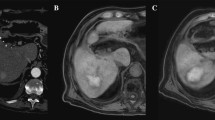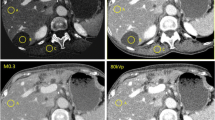Abstract
Background: When attempting to interpret CT scans after radiofrequency thermal ablation (RFA) of liver tumors, it is sometimes difficult to distinguish ablated from viable tumor tissue. Identification of the two types of tissue is specially problematic for lesions that are hypodense before ablation. The aim of this study was to determine whether quantitative Hounsfield unit (HU) density measurements can be used to document the lack of tumor perfusion and thereby identify ablated tissue.
Methods: Liver spiral CT scans of 13 patients with 51 lesions undergoing laparoscopic RFA for metastatic liver tumors within a 2-year time period were reviewed. HU density of the lesions as well as normal liver were measured pre- and postoperatively in each CT phase (noncontrast, arterial, portovenous). Statistical analyses were performed using Student's paired t-test and ANOVA.
Results: Normal liver parenchyma, which was used as a control, showed a similar increase with contrast injection in both pre- and postprocedure CT scans (56.4 ± 2.4 vs 57.1 ± 2.4 HU, respectively; p= 0.3). In contrast, ablated liver lesions showed a preablation increase of 45.7 ± 3.4 HU but only a minimal postablation increase of 6.6 ± 0.7 HU (p < 0.0001). This was true for highly vascular tumors (neuroendocrine) as well as hypovascular ones (adenocarcinoma).
Conclusions: This is the first study to define quantitative radiological criteria using HU density for the evaluation of ablated tissues. A lack of increase in HU density with contrast injection indicates necrotic tissue, whereas perfused tissue shows an increase in HU density. This technique can be used in the evaluation of patients undergoing RFA.
Similar content being viewed by others
Author information
Authors and Affiliations
Additional information
Received: 1 March 2000/Accepted: 4 April 2000/Online publication: 9 August 2000
Rights and permissions
About this article
Cite this article
Berber, E., Foroutani, A., Garland, A. et al. Use of CT Hounsfield unit density to identify ablated tumor after laparoscopic radiofrequency ablation of hepatic tumorsrid=""id=""Presented at the annual meeting of the Society of American Gastrointestinal Endoscopic Surgeons (SAGES), Atlanta, Georgia, USA, 29 March–1 April 2000. Surg Endosc 14, 799–804 (2000). https://doi.org/10.1007/s004640000236
Published:
Issue Date:
DOI: https://doi.org/10.1007/s004640000236




